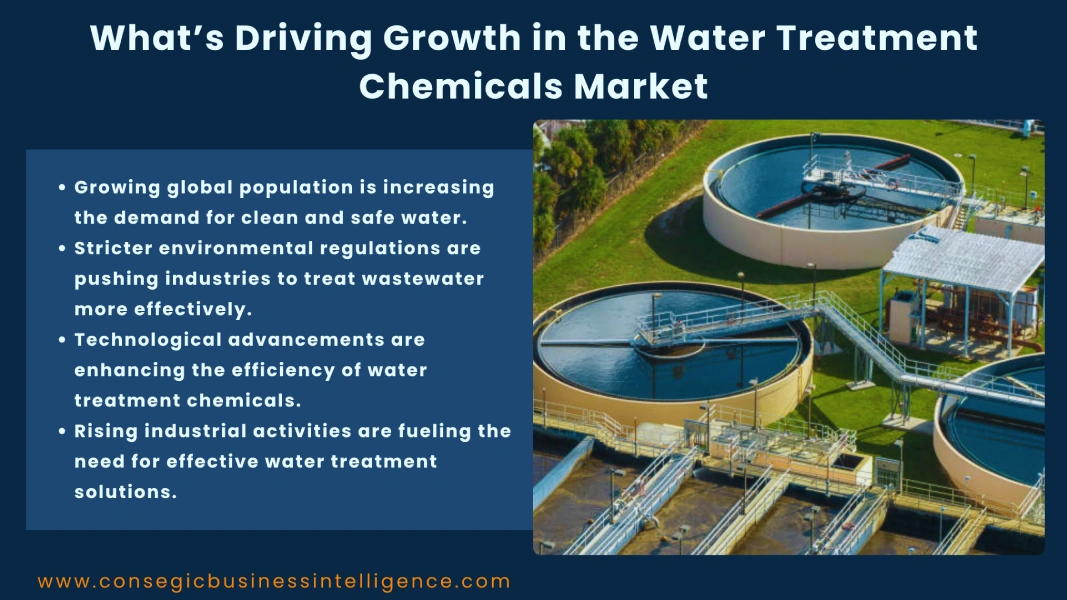What's Driving Growth in the Water Treatment Chemicals Market?
Water treatment is a critical solution for both wastewater and drinking water treatment. Key types of chemicals used in drinking and wastewater treatment such as coagulants, disinfectants, acids, bases, corrosion inhibitors, among others serve indispensable role to make sure of the safe drinking water, managing industrial processes efficiently, and protecting aquatic ecosystems from pollution. As a result, the confluence of demographic, environmental, and industrial factors are positively impacting the market for water treatment chemicals. This article explores the key factors driving the water treatment chemicals market further supporting the advancements.

1.Growing Awareness of Water Quality and Safe Drinking Water
There is increasing awareness regarding the importance of water quality and safety among industries, governments, and the public across the globe. The emphasis on public health and the recognition of water-borne diseases is rising. This has resulted in high concern for the quality and safety of drinking water. One of the prominent factors is that waterborne diseases continue to present substantial threats for health. With improving healthcare systems and public health awareness, demand for safe drinking water to prevent waterborne illnesses is greater to improve overall health outcomes. The increasing awareness of the health risks which are associated with consuming contaminated water has fuelled the demand for safe drinking water. This pervasive awareness thus directly translates into a robust and sustained demand for a wide array of water treatment chemicals.
2. Stringent Environmental Regulations
One of the prominent factors fuelling the demand for water treatment chemicals is the stringent environmental regulations imposed by government and international organizations worldwide. Regulatory bodies across the globe such as U.S. Environmental Protection Agency (EPA) in the United States, the European Environment Agency (EEA) and directives from the European Commission (EC) in Europe among others are increasingly enacting and implementing rigorous standards concerning industrial water discharge and municipal wastewater and drinking water as well. The purpose of regulations is to protect public health, prevent ecological damage, and ensure sustainable water management. Thus, aligning with standards, industries and municipalities are mandated to treat water to meet specific discharge limits for pollutants, heavy metals, organic matter among others and invest in advanced water treatment technologies. Thus, correspondingly this creates the adoption of chemicals driving consistent market growth.
3. Aging Water Infrastructure
The surge in demand for safe drinking water creates pressure on existing water treatment facilities to expand their capacity and improve their efficiency. Many regions, including both the well-developed and developing countries, are facing the issue of aging water infrastructure. The key problems such as deteriorating pipelines, outdated treatment plants, and inefficient distribution networks are leading to ineffective water treatment. Such aging infrastructure results in issues which generally include corrosion, scaling, biofouling, and leaks among others. These issues compromise water quality and lead to significant water losses. Water treatment chemicals effectively address these problems such as corrosion inhibitors work on protecting pipes and equipment, whereas scale inhibitors prevent mineral buildup in boilers and cooling towers, and biocides control microbial growth. Such ongoing need for maintenance, rehabilitation, and optimization of existing water systems to extend their lifespan and ensure efficient operation directly fuels the demand for these protective and performance-enhancing chemicals.
4. Advancements in Water Treatment Chemicals
The demand for novel chemicals formulations increases as the requirements for solutions which are effective, efficient, and environmentally sustainable from both the industrial wastewater treatment and municipalities grows. Some of the key advancements include the development of advanced polymeric and hybrid coagulants that reduce sludge and improve performance. Novel disinfectants such as advanced oxidants for enhanced contaminant destruction and minimized disinfection by-products are also being developed. Also, specialized chemicals are emerging for membrane technologies, such as high-performance antiscalants among others. Moreover, the adoption of greener, biodegradable formulations is positively impacting the market. These innovations majorly help with superior performance in contaminant removal, reduced dosage requirements, lower operational costs, enhanced compliance with evolving regulatory standards, and others.
5. Emergence of New Contaminants
The emergence of new and increasingly complex contaminants serves as a critical driver for the water treatment chemicals market. As analytical capabilities improve, a growing array of micropollutants, including pharmaceuticals, personal care products (PPCPs), microplastics, and per- and polyfluoroalkyl substances (PFAS), are being detected in water sources globally. These contaminants often resist conventional treatment methods, necessitating the development and adoption of highly specialized chemicals and advanced oxidation processes. This ongoing challenge compels continuous innovation in chemical formulations, creating new market opportunities for suppliers to provide targeted, effective solutions for these persistent and environmentally concerning substances.
Conclusion
The water treatment chemicals market is experiencing robust growth, propelled by the combination of growing awareness, stringent environmental regulations, and the urgent need to upgrade aging infrastructure coupled with continuous technological advancements and emergence of new contaminants. These factors ensure a sustained and expanding demand for innovative chemical solutions. The market's trajectory is firmly upward, reflecting its indispensable role in securing a sustainable water future for all.
